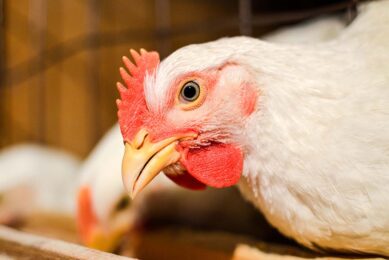Layer breeding: Impact of feed-borne pathogens and strategies for mitigation

The reproductive performance of layer breeders is crucial to the success of commercial egg production, and maintaining the health and productivity of these birds requires a careful approach to feed management.
Feed-borne pathogens pose a significant threat to layer breeders, impacting their health, egg production, and overall flock productivity. This article explores the most common feed-borne pathogens, their effects on egg production, and strategies for mitigating these risks.
Common feed-borne pathogens affecting reproductive performance
Salmonella, E. coli, and Clostridium perfringens are prevalent feed-borne pathogens that significantly impact the reproductive performance of layer breeders, leading to health issues that directly affect egg production and quality. These pathogens can disrupt the microbiome, causing enteritis in layer production systems and affecting flock uniformity, egg production and feed conversion rates.
Salmonella is the most studied feed source pathogen, with over 500 publications available. Studies have shown varying contamination rates in feed and feed ingredients, such as a 12.5% contamination rate documented in the US (2002-2009). Pathogens like Salmonella have been detected in different feed ingredients, including animal-derived proteins, oilseed meals, and cereal grains. High incidences of Clostridium spp. and E. coli have also been reported in studies evaluating pathogen prevalence in feed mills.
“Salmonella can cause salmonellosis, leading to decreased egg production and poor egg quality, with potential spreading to the reproductive organs causing inflammation and damage,” says Jorge Trindade, MBA DVM, Anitox regional sales director EMEA. “E. coli, another significant pathogen, results in colibacillosis, which inflames the oviduct and reduces egg production, proliferating rapidly within flocks and further impacting productivity. Clostridium perfringens, responsible for necrotic enteritis, impairs nutrient absorption, and although it normally doesn’t directly affect the reproductive organs, the resulting health decline can indirectly impact reproductive performance.”
In addition to bacterial threats, fungi that produce mycotoxins are also a concern for layer breeders.
“Aflatoxins, produced by Aspergillus species, can lead to liver damage, reduced egg production, and poor eggshell quality. Mycotoxins can accumulate in feed ingredients, especially under poor storage conditions, continuously threatening poultry health,” notes Trindade.
Influence of pathogens on egg production and flock productivity
Feed-source pathogens can profoundly impact egg production rates, egg quality and long-term flock productivity. The process of reaching sexual maturity and commencing egg laying in hens is not solely dependent on light management strategies but also on achieving critical nutrition requirements.
Contaminated feed introduces pathogens that disrupt the normal functioning of the immune and digestive systems, leading to inflammation, nutrient malabsorption, and a general decline in bird health. This disruption not only affects egg yield but also increases the risk of disease outbreaks, as the weakened birds are more susceptible to infections.
“When pathogens are introduced during the rearing phase, the immune system of the pullets is constantly triggered as it engages in fighting these invaders. This ongoing immune response diverts energy and nutrients that would otherwise be used for growth and reproductive development,” Trindade explains.
“As a result, the bird’s ability to reach maturity and lay eggs is compromised, leading to delays in egg production and a decrease in the quality of the eggs produced. The uniformity of the flock is also affected, as pathogens can cause variability in the growth and development of individual birds. This lack of uniformity can lead to further challenges in managing the flock and maintaining consistent egg production.”

Impact of feed-borne pathogens on genetic performance
Feed-source pathogens can have far-reaching effects on genetic performance, disrupting the optimisation of desirable traits and hindering the overall genetic advancement of poultry flocks.
Contaminated feed disrupts normal growth patterns by causing digestive disorders and reducing nutrient availability. Consequently, birds experience reduced growth rates, poor feed conversion ratios, and diminished reproductive performance. For example, Salmonella can translocate from the gastrointestinal tract to the reproductive organs, leading to inflammation and damage that reduces fertility.
Trindade explains: “The stress imposed gut health challenges can affect the birds’ overall vitality and reproductive efficiency, ultimately, impairing the birds’ ability to reach their genetic growth potential and skewing genetic evaluations. Breeders rely on accurate performance data to select the best breeding stock, and feed-source pathogens can obscure the true genetic potential of birds by introducing variability in growth performance unrelated to genetics.”
To mitigate the impact of feed-borne pathogens on genetic performance, it is essential to implement robust prevention and control measures. For producers, this requires regular monitoring of feed quality, stringent hygiene practices, effective pathogen management and incorporation of feed additives that enhance gut health and immune function.
Multi-point intervention programmes
Preventing feed-borne pathogen contamination is crucial for maintaining the health and productivity of layer breeders. A new cost-effective solution, Anitox’s Multi-Point Intervention Programs (M-PIPs), takes a scientific approach by targeting the highest-risk areas in the feed production process. Unlike traditional methods that treat the entire volume of feed, M-PIPs focus on pre-treating high-risk raw materials, eliminating legacy bacteria in mills and protecting finished feeds from recontamination.
“This approach is currently supported by Anitox products, Finio and Fortrol, which are proven effective through ongoing research and development. Legacy bacteria, persistent in the feed manufacturing environment, can lead to feed contamination, especially post-heat treatment. The cooling process can introduce moisture, making the feed more susceptible to microbial growth. M-PIPs address these challenges by targeting high-risk ingredients and passing chemically mitigated material through the feed production system, significantly reducing microbial loads and mitigating pathogen transmission. This targeted intervention strategy not only ensures clean feed production but also supports sustainability and biosecurity objectives by minimizing chemical use while maximizing impact,” says.
Producers can learn more about how to minimize the risks associated with feed-borne pathogens, protect egg production and ensure the long-term productivity of their layer breeder flocks by joining Anitox Clean Feed Experts during EuroTier at booth D19 or visiting www.anitox.com.






